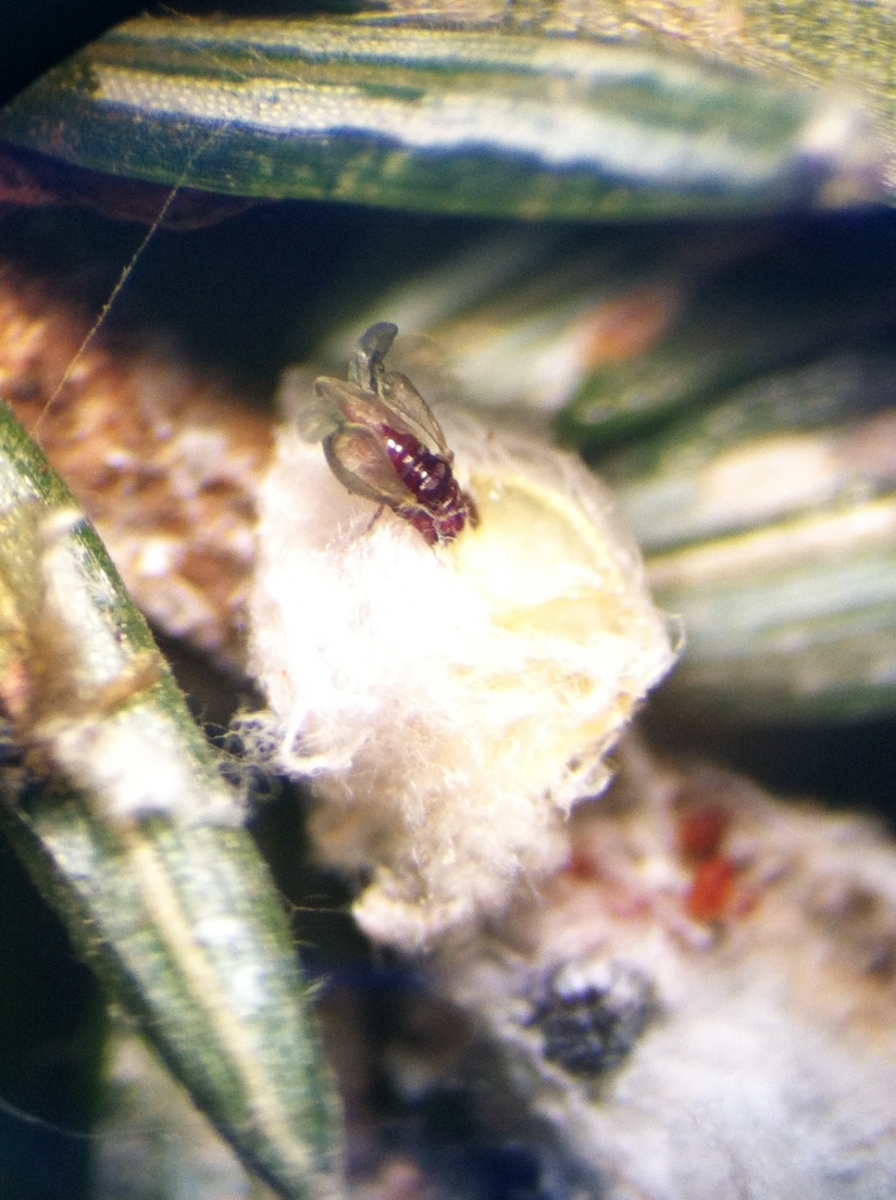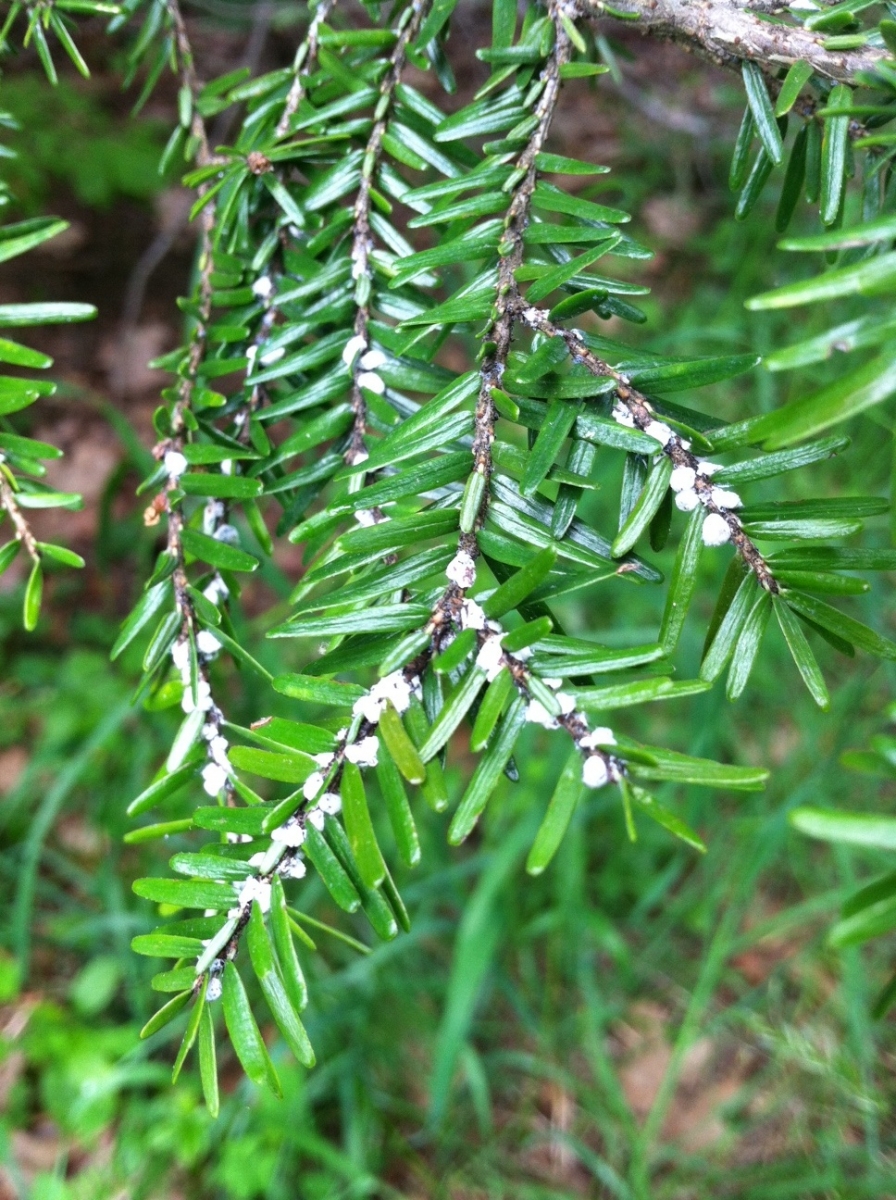You are here
Hemlock trees and their pests
We got out of the truck at one of our research sites and saw two older women painting a picture of the forested road in afternoon sunlight. It was a beautiful scene, but what the artists didn’t know was that they were surrounded by stressed, thinning, and sick hemlock trees infested with the Hemlock Woolley Adelgid (HWA), the invasive insect pest currently attacking Eastern Hemlock Trees.
Hemlock trees are a ‘foundation species’ of forests. They are long-living, shade tolerant conifers that usually grow in groups or are assembled with other tree species. Hemlocks contribute to watershed quality and provide a unique micro-environment with a cool habitat for many species of birds, insects, and mammals. Since the 1950s, hemlock trees have been in a widespread decline due to the introduction of the Hemlock Woolly Adelgid from Japan. The HWA cause foliar damage, crown loss and mortality by inserting a feeding tube into the base of hemlock needles and suck the nutrients from the tree stem. They cover themselves with a white wool-looking substance where they lay over 200 eggs per wool sac.
More recently, researchers have seen even more stress on hemlock populations due to yet another invasive, non-native pest called the Elongate Hemlock Scale (EHS). The EHS differ from the HWA because they cause foliar discoloration by sucking nutrients directly from the hemlock needles and covering themselves in a waxy cuticle. Usually, a hemlock tree first becomes infested with the HWA and then with EHS soon after.
This summer, our research asks if these two pests intensify the damage to hemlock, or slow hemlock decline due to competition for resources. To answer this question, we use a combination of field and laboratory work for research on the many elements contributing to this question. Out in the field with our mentor David Orwig, we go to different previously established plots that were designated as HWA infested, EHS infested, both HWA and EHS, or none. At these sites, we collect small pieces of the branches, called branchlets, to take back to the lab for analysis.
Under the dissecting microscope, these branches are telling an incredible story. You can see the tiny insects up close, the adelgids slowly, grossly throbbing on the needle base, covered in their wool. If you lightly pull back the wool cover, eggs that look like miniscule grapes poke out from the branch. The EHS are slimy, snot-like blobs on the leaves and bright yellow ‘crawlers’ hide beneath the covers. This week, we have been lucky to see the rare form of the adelgid life cycle: the winged male adelgids. Usually, the life cycle is considered “parthenogenic” which means that reproduction occurs without any males, and all HWA are females and produce clone daughters, but sometimes, winged males will emerge and fly away for dispersal purposes. These males often have trouble figuring out how to fly their wings!
 Another layer up close on the hemlock needles is the diverse world of microbes. Microbial communities are everywhere and contribute to many processes that people often take for granted. Microbial communities are made up of different fungi, bacteria, and other microorganisms that are major contributors to decomposition and nutrient cycling in all environments. This summer, we are going to study how these microscopic leaf communities change when the invasive pests are present. If these communities are changing, it has huge implications for forest processes on small (directly to individual trees) and large scales (nutrient cycling). We will research if the outer covering of these two insects (wool/wax) provide resources that enhance microbial abundance. We are currently finalizing our protocol for studying these microbial communities because this is fast growing area of science where new, better and more accurate techniques are being developed as we speak!
Another layer up close on the hemlock needles is the diverse world of microbes. Microbial communities are everywhere and contribute to many processes that people often take for granted. Microbial communities are made up of different fungi, bacteria, and other microorganisms that are major contributors to decomposition and nutrient cycling in all environments. This summer, we are going to study how these microscopic leaf communities change when the invasive pests are present. If these communities are changing, it has huge implications for forest processes on small (directly to individual trees) and large scales (nutrient cycling). We will research if the outer covering of these two insects (wool/wax) provide resources that enhance microbial abundance. We are currently finalizing our protocol for studying these microbial communities because this is fast growing area of science where new, better and more accurate techniques are being developed as we speak!
 Finally, we are studying the Carbon and Nitrogen atoms within these leaves. We collect the branchlets from different sites, measure the length, and count the number of HWA, EHS, or both. We then remove the needles and dry the needles and twigs in small coin envelopes. The needles or twigs are then made into a fine powder, and will be analyzed for their Carbon/Nitrogen ratio. In previous studies, they have found that trees with HWA are higher in nitrogen content, leading to changed soil chemistry (from needlefall), decomposition, and subsequently different understory habitats – a disruption of forest function. We are going to look at the Carbon to Nitrogen ratios for needles with EHS and both insects. This will give us insight into how these insects are interacting on the trees, and changing the chemistry of trees themselves as well as the overall forest systems.
Finally, we are studying the Carbon and Nitrogen atoms within these leaves. We collect the branchlets from different sites, measure the length, and count the number of HWA, EHS, or both. We then remove the needles and dry the needles and twigs in small coin envelopes. The needles or twigs are then made into a fine powder, and will be analyzed for their Carbon/Nitrogen ratio. In previous studies, they have found that trees with HWA are higher in nitrogen content, leading to changed soil chemistry (from needlefall), decomposition, and subsequently different understory habitats – a disruption of forest function. We are going to look at the Carbon to Nitrogen ratios for needles with EHS and both insects. This will give us insight into how these insects are interacting on the trees, and changing the chemistry of trees themselves as well as the overall forest systems.
It is hard to describe the feeling of walking through a stand of hemlocks but there is a deep of calmness and quietness about these forests. We feel lucky to be able to study and enjoy the beauty of these trees this summer because they are rapidly declining and may eventually disappear from our forests due to these pests.


